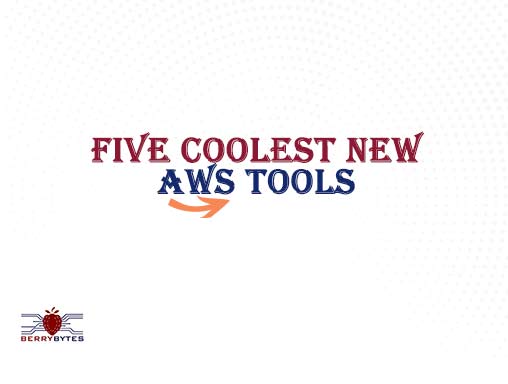
Five coolest new AWS tools
BerryBytes
- 0
- 652
AWS is the most popular cloud platform globally, utilized by both startups and large corporations. It is a one-stop shop for all cloud services, including data storage and analytics. The simplicity and cost-effectiveness of AWS’s cloud services/tools enable businesses to increase their efficiency and performance. Similarly, these services provide a wide variety of additional capabilities to serve customers in various ways.
Amazon maintains global data centers linked to a vast network that guarantees reduced global delay. AWS’s replication features let you copy services in different regions. This allows the user to gain access quickly and avoid costly downtime.
Here is a list of the five coolest AWS tools you should be familiar with.

-
Amazon EC2 (Elastic Compute Cloud)
It is an Amazon Web Services cloud computing service (AWS) that provides highly scalable computing capacity, allowing users to scale up or down as necessary. EC2 enables users to launch instances, which are virtual servers preconfigured with a variety of operating systems and software applications. Flexibility is one of EC2’s primary benefits. Users are able to create and modify instances as necessary, also can scale them up or down to accommodate fluctuating demand. Similarly, the service provides numerous security and networking options, allowing users to control access to their instances and resources. Amazon EC2 is a cheap and straightforward method for hosting and managing cloud-based computing resources.
-
Amazon S3 (Simple Storage Service)
It is a service for object storage offered by AWS, which offers a secure, scalable, and long-lasting storage solution for data of any size, type, or workload. S3 is designed to store and retrieve any amount of data that is web-accessible. It employs a simple web service interface that permits users to store and retrieve data using standard HTTP requests. Durability is one of the main advantages of using S3. The capacity of data across multiple devices and facilities is designed to withstand the loss of two facilities at the same moment. In addition, the service provides many security and compliance options, enabling users to protect their data and adhere to regulatory requirements. AmazonS3 is an effective and reliable storage solution for a variety of applications, such as file storage, backup and recovery, and big data analytics.
-
Amazon RDS (Relational Database Service)
It is a fully managed database service provided by AWS that simplifies deployment, administration, and scalability of cloud-based relational databases. RDS supports Amazon Aurora, PostgreSQL, MySQL, MariaDB, Oracle, and Microsoft SQL Server as database engines. It handles many of the administrative tasks associated with running a database, including backups, patching, and monitoring, letting developers focus on building applications. RDS is also highly scalable, allowing users to increase or decrease compute and storage resources as necessary. Overall, Amazon RDS is a simple and cost-effective method for hosting and managing relational databases in the cloud.
-
Amazon Lambda
It is an Amazon Web Services computing platform that does not require a server and allows users to run code when specific events occur, such as when data in an Amazon S3 bucket is modified or a new line is introduced to a stream in Amazon Kinesis. Amazon Lambda abstracts away the underlying infrastructure, allowing users to focus purely on writing and maintaining code. The service automatically scales to meet demands of application, and users only pay for the amount of compute time consumed. This framework can be used to create anything from straightforward back-end services to complex event-driven applications. It can respond to events from non-AWS services and is simple to integrate with other AWS services. Amazon Lambda is an effective and easy method for developing and deploying serverless cloud applications.
-
Amazon CloudFront
A content delivery network (CDN) is provided by AWS, which accelerates the delivery of static and dynamic web content, such as HTML, CSS, JavaScript, and images, to users by serving it from a global network of edge locations. By using CloudFront, you can decrease the load on your servers and improve the performance of your website or application. The service is compatible with S3 and EC2 and can also be used to deliver content from outside of AWS. In addition, it provides options for securely delivering content, such as Secure Sockets Layer (SSL) and Transport Layer Security (TLS) protocols. Amazon CloudFront is a dependable and flexible content delivery network (CDN) that can deliver content to users worldwide.
In conclusion, the five coolest Amazon Web Services (AWS) tools are powerful and valuable resources for businesses and developers seeking to create and operate cloud-based applications and services. AWS tools offers distinct set of capabilities and used to solve variety of problems and meet wide range of needs.

